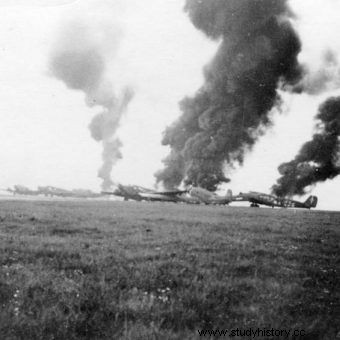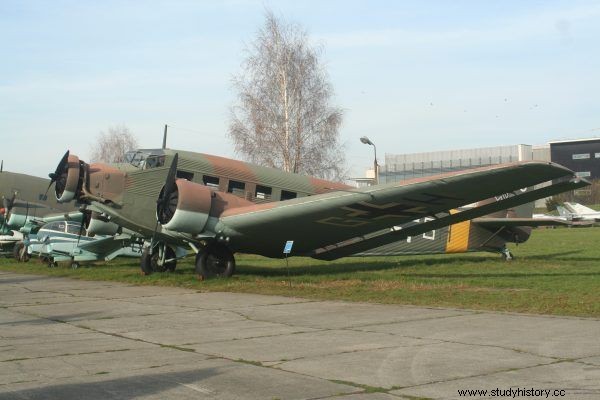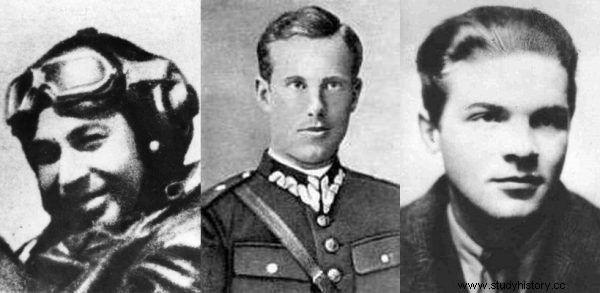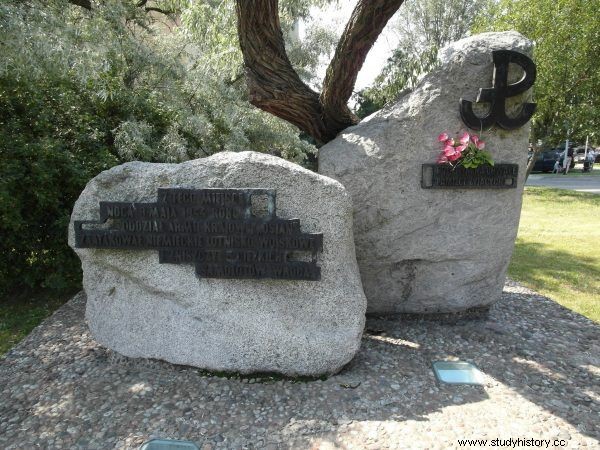The Luftwaffe was a terror among the Allied Air Force. The Home Army did not have any weapons that could compete with the German aviation. However, she managed it anyway. And that's perfect
Home Army units, due to the lack of anti-aircraft weapons, did not pose a major threat to the Luftwaffe. The odds were leveling on the ground. Of course, the actions of destroying planes at airports and landing sites also required appropriate equipment and were associated with a great threat from the enemy. Nevertheless, the Home Army performed several activities of this type in various territories of occupied Poland.

Burning Junkers Ju 52.
On the night of May 3–4, 1944, soldiers from the special unit of the Kedyw KG AK, codenamed "Sawicz" under the command of Sgt. cadet pil. Aleksander Wąsowicz "Spada" burned five German planes at the Bielany airport in Warsaw.
Meticulous plan
The construction of the Bielany airport, planned as a sports airport, started in 1938. It stretched from today's ul. Lindego and ul. Kasprowicz to the north, almost to the Vistula and the Młociński Forest. During the war it was expanded by the Germans. Four Luftwaffe reconnaissance squadrons were stationed there periodically. In addition, it was the base from which flights with weapons and supplies to the Wehrmacht troops on the Eastern Front took place.

Planes supplying the eastern front took off from the airport in Warsaw's Bielany. In the photo Junkers Ju 52 / 3m g14e from the Polish Aviation Museum in Krakow, a machine similar to those in 1944 in Bielany.
From mid-1943, the Home Army planned to perform a combat action at the airport. The initiator of the preparations was Cpt. Jan Kajus Andrzejewski "Jan", commander of the special unit of Kedyw KG AK, codenamed "Osjan". Reconnaissance of the area revealed that there were several German three-engine Ju-52 / 3m transport aircraft on the scene. One of the arguments in favor of carrying out the strike was the fact that the machines were loaded with equipment for German troops fighting in the East.
In the spring of 1944, the plan was ready for implementation. The action was to be carried out by the "Osjan" unit, whose command, after Andrzejewski was transferred to a higher position, was assumed by Lieutenant Julian Barkas "Sawicz". The development of the attack plan was entrusted to two subordinates of "Sawicz":Sgt. cadet pil. Aleksander Wąsowicz "Spad" and Sgt. cadet Jerzy Zaufall "Oliwa". The idea was to create two independent concepts of impact. It was a kind of test for young soldiers in terms of preparation of subversive activities. The final plan was to combine the Spada and Oliwa projects.
The power of cooperation
The action itself was an officer's exam for Wąsowicz, who took command. Zaufall became his deputy. Cpt. "Jan". The date of the action was scheduled for the night of May 3–4, 1944, May 3, at approx. 21.00 in the basement of an unfinished house at the intersection of ul. Kasprowicz and al. Reunification, a briefing of 18 soldiers assigned to destroy the planes took place.
After the briefing, the group headed for Bielany. They approached the airport from the cemetery in Wawrzyszewo Stary. According to an earlier reconnaissance, it was the part of the airport with the least protection by German troops. The akovs crossed the fence by cutting the net.
The plan assumed that loads with plastic explosives, the so-called plastic with an attached gunpowder fuse. 10 people took part in the implementation of this part of the plan, two per plane. The first person, with the help of a partner, jumped on the junker's wing, put on the explosive and dropped the fuse from the wing so that it could be launched from the ground. After the miner descended, the second conspirator went to the commander of the action in order to inform him that he was ready to blow up the machine.
Confused Germans
When five of the indicated soldiers reported to Wąsowicz, he whistled, signaling that the fuses were set on fire and evacuated. After some time, loud explosions shot the air at uneven intervals. The "Bleed" signaled a retreat. However, at the same time, the saboteurs were fired upon by a German patrol who had to spot them in the light of the fires. After a short response with fire, the performers withdrew without major losses. Only one of the boys received a harmless but embarrassing shot in the buttock.

Three heroes of the Bielany action:Aleksander Wąsowicz ps. "Spad", Jan Kajus Andrzejewski pseud. "Jan" and Jerzy Zaufall pseud. "Oil". The first photo comes from the book "AK 75. Daring actions of the Home Army", the other two - from the public domain.
As a result of the action, five planes with bombs detonated burned down. In addition, three more machines suffered minor damage as a result of explosions and fires. As a reward for the exemplary action "Spad" he was promoted to second lieutenant and received the Cross of Valor. Other participants of the action were also honored.
The Germans were completely taken aback by the destruction of the planes. Initially, they attributed the explosions to the Soviet bombing. As Władysław Bartoszewski wrote about their reaction:
Various colorful rockets shot up into the sky. After a while the siren sounded in Okęcie, and soon alarm sounds were heard throughout the city. Anti-aircraft artillery searchlights illuminated the sky again and again in search of enemy planes.

A monument commemorating the action, located in Wawrzyszew. The inscription reads:"From this place on the night of May 3, 1944, a detachment of the national army OSJAN attacked the German military airfield." The photo comes from the book "AK 75. Daring actions of the Home Army".
However, after investigating the case, the German security services came to the conclusion that it was the work of the Polish underground. According to Tomasz Strzembosz, four houses in Wawrzyszew were burned, and in the forest near Łomianki, the Germans most likely shot eight men arrested in the village.
A double action or a simple mistake?
On May 18, "Biuletyn Informacyjny" published the following information: In Warsaw at night from 3 to 4 May 44. our troops carried out an action at the Bielany Airport, destroying 5 transport planes (3-motor Junkers) and damaging 3 more. The fire lasted several hours . What is puzzling, however, is the report of the German police on May 4, 1944, in which we read:
At 0.05 two unknown men placed an explosive under the motorbike of the 3-engine Ju 52 parked at the Okęcie airport. The explosion completely destroyed the plane. The airport was guarded by 2 double checkpoints which noticed 2 people running away .
Were there two actions of this type that night? However, did fewer planes burn in Bielany than indicated in the AK communiqué, and did the Germans mistake the airports in the report?
